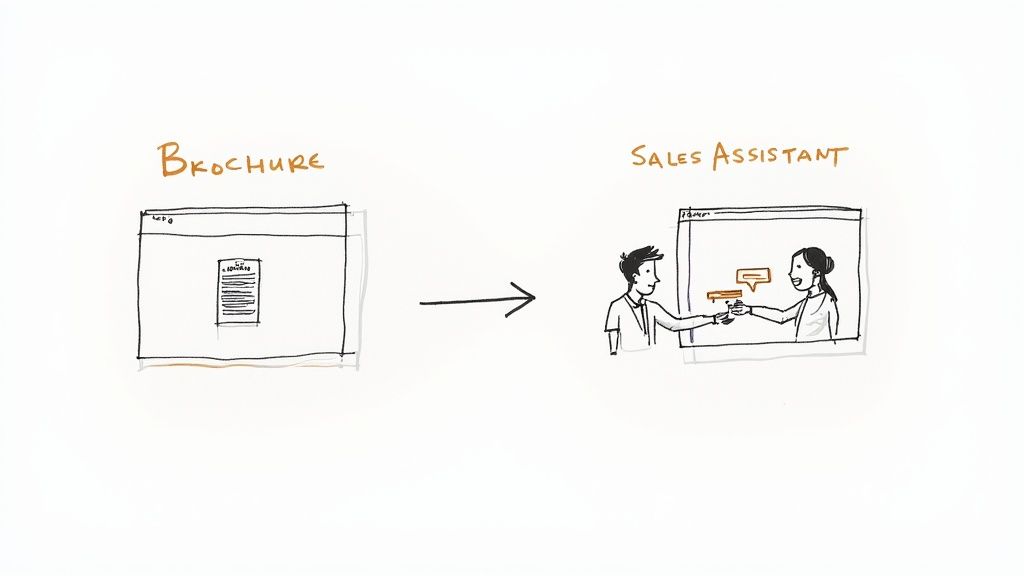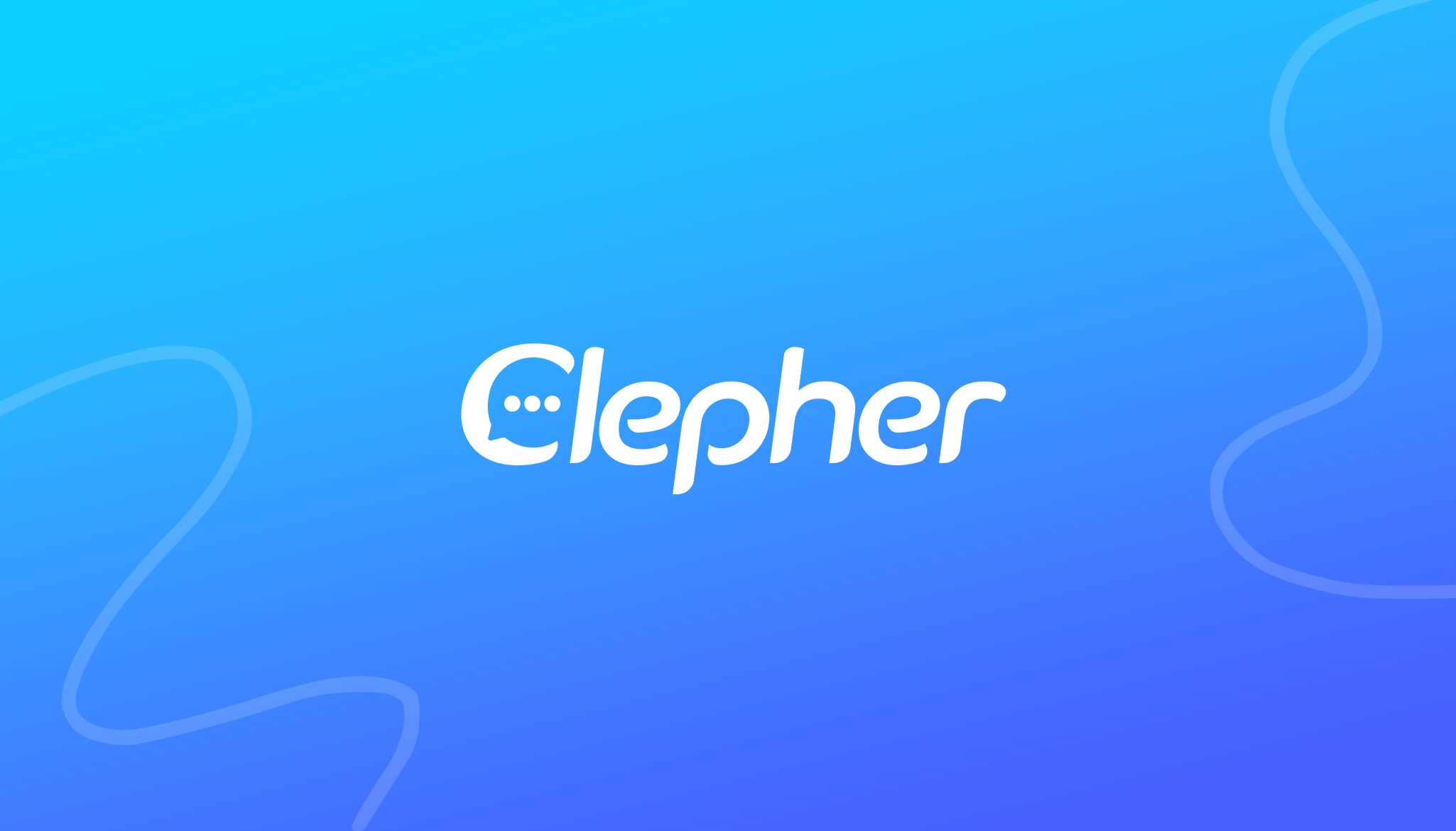Using chatbots in marketing isn’t just about adding a shiny new tool to your website. It’s a fundamental shift in how you connect with customers. Imagine turning every passive website visit into a real-time, one-on-one conversation that guides, helps, and converts visitors—24/7.
That’s the power of a marketing chatbot. It meets your buyers where they already are—your website, your social media—and gives them instant answers. It’s the difference between a static digital brochure and a dynamic, interactive sales assistant that captures leads and builds relationships on autopilot.
The Shift to Conversational Marketing
Think of a typical website. It’s a digital monologue. It presents information, but it can’t talk back. When a visitor has a specific question or gets lost, their only option is to fill out a form and wait. That delay is where you lose people.
Now, add a chatbot. Your website is no longer silent; it’s an active, always-on guide. It can greet every visitor, ask what they’re looking for, and provide an answer on the spot. This isn’t just an improvement; it’s a transformation from broadcasting a message to having a real dialogue.
From Monologue to Dialogue
This evolution is the core of conversational marketing—a strategy built on building relationships through real-time conversations. If you want to dive deeper, we have a complete guide on what conversational marketing is. Instead of making potential customers wait, you engage them the moment their interest is highest.
This instant interaction achieves several key marketing goals at once:
- Boosts Engagement: Visitors who chat are far more likely to stick around and explore what you offer.
- Qualifies Leads Instantly: The bot asks the right questions to separate hot leads from casual browsers, saving your sales team valuable time.
- Adds a Human Touch: A well-designed chatbot feels personal and supportive, not robotic. It makes the digital experience feel more human, which is a massive win for your brand.
The market growth tells the story. The global chatbot market is exploding, jumping from $2.47 billion in 2021 to a projected $15.57 billion by 2025. Forecasts even predict it could hit an incredible $46.64 billion by 2029, driven by the business world’s demand for better customer connections.

From Monologue to Dialogue
A marketing chatbot isn’t just a tool; it’s a strategic decision. It’s about meeting modern customer expectations for speed and personalization. It turns every interaction into a chance to build trust and drive growth.
Ultimately, using chatbots in your marketing is about being more helpful, more available, and more tuned in to what your customers actually need. This move from monologue to dialogue isn’t a trend—it’s the new standard for effective marketing.
Why Chatbots Are a Marketing Game Changer
Chatbots are more than just a cool tech feature; they are powerful marketing engines that solve some of the oldest problems in business. They work around the clock, ensuring you never miss an opportunity to connect with a potential customer. Think of it this way: a chatbot transforms your website from a passive brochure into an active, lead-generating machine.
By automating those first critical interactions, chatbots free up your team to focus on what humans do best—closing deals and building strategic relationships. The results speak for themselves. Site visitors who have a meaningful conversation with a chatbot are five times more likely to convert into a sales opportunity. That single statistic reveals why chatbots have become indispensable for growth.
Capture and Qualify Leads 24/7
Your marketing doesn’t stop when your team goes home, and neither should your lead capture. A potential customer browsing your services at 10 PM on a Saturday is just as valuable as one visiting during business hours. Without a chatbot, that lead is likely lost forever.
A marketing chatbot acts as your always-on receptionist. It greets every visitor, asks smart qualifying questions, and captures contact information so no lead ever slips through the cracks.
B2B Scenario: Booking a Demo After Hours
Imagine a marketing manager from a target company lands on your pricing page late at night. The chatbot instantly engages: “Hi there! Exploring our plans? I can help find the right fit or schedule a quick 15-minute demo. What works best for you?” The manager immediately books a time slot on your sales team’s calendar for the next morning. This seamless process captures hot leads at their peak moment of interest.
Deliver True Personalization at Scale
Personalization is the holy grail of marketing, but creating a tailored experience for thousands of visitors is a huge challenge. Chatbots solve this by enabling one-to-one interactions at scale, making every visitor feel understood.
They achieve this by analyzing user behavior, asking direct questions, and using past data to guide users to the most relevant products or content. This is personalization that goes far beyond just using a visitor’s first name in an email.
Chatbots make hyper-personalization a practical reality. They act as individual shopping assistants or solution guides for every user, dramatically improving the customer experience and boosting conversion rates.
Retail Scenario: Finding the Perfect Gift
A customer visits an e-commerce store looking for a birthday present. The chatbot starts the conversation: “Welcome! Shopping for a special occasion? Let’s find the perfect gift. Who is it for, and what’s your budget?” Based on their replies, the bot presents a curated list of top-rated products with reviews and an easy add-to-cart button. This guided journey is far more effective than leaving customers to navigate endless product pages alone.
Free Up Your Team for High-Value Work
One of the biggest benefits of AI chatbots is their ability to handle the repetitive, time-consuming tasks that bog down marketing and sales teams. By automating front-line inquiries, you empower your people to focus on complex problem-solving and nurturing high-value relationships. You can discover more about the key benefits of AI chatbots in our detailed guide.
Chatbots have become a dominant force for a reason. The data shows that 69% of users find chatbots helpful, and a massive 39% of all business-to-consumer chats now involve a chatbot. This isn’t just hype; it’s proof of their efficiency and impact on real marketing goals.
Putting Chatbot Marketing Strategies into Action
Knowing chatbots are powerful is one thing; putting them to work is another. This is where the real value of chatbots in marketing emerges. The key is to see your chatbot not as a single tool, but as a specialist that can handle specific jobs all along the customer journey.
Whether it’s capturing a new lead’s attention or delighting a loyal customer, a well-designed chatbot acts as a direct extension of your marketing team. Let’s break down the most effective, actionable strategies you can implement right away.
Generate and Qualify Leads on Autopilot
One of the biggest wins a chatbot can deliver is turning your website into an active lead generation machine. Instead of making visitors search for a contact form, a chatbot can proactively engage them, ask qualifying questions, and identify who is a hot lead versus who is just browsing.
Imagine a potential B2B client lands on your pricing page. You have only seconds to act.
- The Goal: Capture their interest and book a demo before they leave.
- Chatbot’s Role: The chatbot pops up with a timely message: “Hey there! Comparing our plans? I can help you find the perfect fit in under 60 seconds. What’s the biggest challenge you’re looking to solve?”
- The Outcome: The bot asks a few smart questions (like company size or key objective) to qualify the lead. If they’re a good fit, it books a demo directly into a sales rep’s calendar. No friction, no waiting.
This automated flow not only captures leads 24/7 but also delivers them pre-qualified and ready for a meaningful conversation. To learn more, check out our guide on building a chatbot for lead generation.
Boost Engagement with Interactive Experiences
Modern marketing is a battle for attention, and static content often loses. Chatbots excel here by creating interactive experiences that draw users into a conversation, making them active participants. Think of quizzes, personalized product finders, or guided tours.
Consider a skincare brand with a large product line, which can be overwhelming for new customers.
- The Goal: Guide users to the perfect product for their needs, making them confident enough to purchase.
- Chatbot’s Role: The bot initiates an interactive quiz: “Ready to find your perfect skincare routine? Let’s start! What’s your skin type?” It then asks simple follow-up questions about their concerns and goals.
- The Outcome: Based on the answers, the chatbot presents a short, curated list of recommended products, explaining why each is a good fit. This guided selling feels personal and helpful, making the purchase feel like a natural next step.
Recover Lost Sales in E-commerce
Cart abandonment is the silent killer of online retail. A customer adds items to their cart, gets distracted, and never returns. A marketing chatbot is your secret weapon for winning back these almost-customers, turning a near-miss into a sale. This is especially effective on platforms like Facebook Messenger or Instagram.
A chatbot’s ability to send a timely, personalized reminder is often the final nudge a customer needs to complete their purchase. It’s a simple strategy with a significant impact on revenue.
For an e-commerce store, the process is incredibly effective:
- The Goal: Nudge shoppers who abandoned their carts to come back and complete their purchase.
- Chatbot’s Role: About an hour after a user leaves their cart, the chatbot sends a friendly message via Messenger: “Hi Alex! Looks like you left a few things behind. We saved your cart for you. Would you like a 10% discount to finish your order?”
- The Outcome: This personal reminder, sweetened with a small discount, brings the customer right back to the checkout page. The sale is saved, and the customer feels valued.
To see how AI tools can significantly boost your sales, read this guide on boosting sales with AI chatbots. These strategies prove that chatbots are dynamic marketing assets that drive real growth at every stage of the customer journey.
Comparing Chatbot Marketing Strategies
To help you visualize where these strategies fit, here’s a quick breakdown of how different chatbot applications align with specific marketing goals.
| Strategy | Primary Goal | Example Use Case | Key Metric (KPI) |
|---|---|---|---|
| Lead Generation | Capture and qualify potential customers | Engaging website visitors on a pricing page to book demos | Number of Qualified Leads Generated |
| Interactive Content | Boost user engagement and guide choices | A skincare brand’s quiz to recommend products | Content Completion Rate / Conversion Rate |
| Cart Recovery | Recapture lost sales and reduce abandonment | Sending a discount offer via Messenger to users with abandoned carts | Cart Recovery Rate / Recovered Revenue |
| Customer Onboarding | Welcome new users and guide first steps | A SaaS bot that walks a new user through setting up their account | User Activation Rate |
Each strategy tackles a different part of the customer journey, but they all share a common thread: using automated, intelligent conversations to move people toward a desired action. The key is to pick the right tool for the right job and measure its success with the right metric.
Choosing the Right Chatbot for Your Marketing Goals
Picking the right chatbot for your marketing is like choosing between a detailed instruction manual and a creative brainstorming partner. Both are useful, but for different tasks. Understanding this distinction is the first step to choosing a solution that fits your strategy, budget, and team’s skills.
On one side, you have rule-based chatbots. Think of these as digital flowcharts. They follow a predefined script based on “if/then” logic. You map out the conversation, and the bot follows your rules perfectly. They are predictable, reliable, and excellent for straightforward tasks.
On the other side are AI-powered chatbots. These are the adaptive partners. Instead of being locked into a script, they use natural language processing (NLP) to understand what a user is saying—typos, slang, and all—and generate a relevant response. They learn from conversations, becoming smarter over time.
Scripted vs. Intelligent: Which One Do You Need?
The choice between rule-based and AI chatbots comes down to your primary marketing goal. Are you guiding users down a specific path, or do you need to handle a wide range of unpredictable questions?
A rule-based bot is your best bet for simple, repetitive tasks.
- Use Case: A restaurant wants a bot to take table reservations. The conversation is straightforward: “How many people?”, “What time?”, “What’s your name?”. A scripted flow is perfect for this.
- Benefit: They are generally cheaper and faster to set up because the logic is simple. You also maintain complete control over every word the bot says.
AI-powered bots are built for complexity and scale.
- Use Case: An e-commerce brand wants to offer personalized product recommendations. The bot needs to understand nuanced requests like, “I’m looking for running shoes for long distances with good ankle support.”
- Benefit: They provide a much more natural, human-like experience and can manage a huge variety of conversational paths without needing to be manually scripted for each one.
This infographic breaks down how your main goal—generating leads or driving sales—can shape your chatbot strategy.
As you can see, whether you’re focused on capturing leads or closing deals, a chatbot can be tailored to either function just by adjusting its conversational flow.
Key Features to Look for in a Chatbot Platform
Once you know the type of bot you need, it’s time to evaluate platforms. The market for AI chatbots in marketing is dominated by a few major players. ChatGPT leads with an 81.37% market share, followed by tools like Perplexity and Microsoft Copilot. This highlights how deeply businesses are integrating these tools. You can find more details in this report on the top generative AI chatbots and their market share.
When comparing options, focus on the core features that will actually drive your marketing forward.
Your chatbot platform should be a growth engine, not a technical headache. Prioritize tools that are easy for marketers to use and that connect seamlessly with the other software you already rely on.
Here are the non-negotiable features you should look for:
- User-Friendly Interface: You shouldn’t need to be a developer to build or adjust a conversation. A good platform will have a visual, drag-and-drop builder, empowering your marketing team to create and refine chatbot flows independently.
- CRM and App Integrations: Your chatbot is a data-gathering tool. It must connect easily with your CRM (like HubSpot or Salesforce), email marketing software, and e-commerce platform to ensure lead and customer data flows seamlessly into your existing systems.
- Robust Analytics and Reporting: You can’t improve what you don’t measure. The platform needs clear dashboards showing key metrics like engagement rates, leads generated, and where users drop off in conversations. This data is essential for optimizing your bot’s performance over time.
- Human Handoff Capability: No bot is perfect. When a conversation gets too complex or a user requests to speak with a person, the chatbot must be able to smoothly transfer the chat to a live agent without losing context.
Your Framework for a Killer Chatbot Launch
A great chatbot idea is one thing; successfully building and launching it is another. A smart, step-by-step approach can be the difference between a bot that customers love and one that causes frustration.
The secret is to start small, get a quick win, and build from there. Don’t try to create a bot that does everything on day one. Instead, pick one specific, high-impact problem to solve. This keeps the project manageable and makes it easier to prove its value.
Nail Down One Primary Goal
Before you write a single line of dialogue, answer this question: What is the #1 job this chatbot needs to do?
Seriously, just one. A bot that tries to be a jack-of-all-trades often ends up being a master of none, creating a clunky, confusing user experience. Give your bot a single, measurable mission.
For example, your primary goal could be to:
- Book More Demos: The bot’s sole purpose is to qualify leads and get them on your sales team’s calendar.
- Guide Product Discovery: It acts as a helpful store clerk, guiding visitors to the right product based on their needs.
- Grow Your Email List: It offers a valuable resource or a discount in exchange for an email address. Simple and effective.
A clear objective serves as your North Star for the entire project, guiding every decision from the first greeting to the final call-to-action.
Give Your Chatbot a Personality
A chatbot without a personality is just a glorified web form. To create an experience that people actually enjoy, infuse it with a voice that aligns with your brand. Is your brand quirky and fun? Professional and authoritative? Warm and helpful?
This personality should be reflected in every message. Consider the details:
- Tone of Voice: Does it use formal language, or is it casual with emojis? The phrasing should match your brand’s communication style.
- Avatar and Name: Give it a name and an avatar that feels like a natural part of your brand, not a generic stock image.
- Greetings and Goodbyes: Craft welcome and sign-off messages that immediately set the right tone.
Think of your chatbot as your newest team member. It’s often the first “voice” a potential customer hears from your company. Making sure it represents your brand well is critical for building trust from the start.
Map Out the Conversation Flow
With a goal and personality in place, it’s time to script the conversation. Map out the user’s entire journey, from their first “hello” to the final outcome. A great conversation flow feels natural, anticipates user questions, and gently guides them toward the objective.
Start with a simple flowchart. What’s the first thing the bot says? What are the most likely user responses? For each response, what happens next? Crucially, always have a plan for when a user goes off-script.
And here’s a non-negotiable: you must plan for a seamless human handoff. No bot can handle every question. When a conversation gets complex or a user asks for a person, the bot needs to transfer the chat to a live agent without friction. This safety net is essential for a positive user experience.
Test, Tweak, and Tell the World
Your chatbot is never truly “done.” Test it thoroughly before it goes live, and then continuously improve it based on real user interactions. Have your own team try to break it by asking strange or unexpected questions.
Once live, dive into the analytics. Look for points in the conversation where people get stuck, confused, or drop off. These are your opportunities for improvement.
Finally, promote your new chatbot! Announce it on social media, mention it in your email newsletter, and make it highly visible on your website. A successful launch is just the beginning of your chatbot marketing strategy.
Measuring Your Chatbot’s Marketing ROI
A chatbot is only as valuable as the business results it drives. To prove its worth, you must look beyond vanity metrics like total conversations and focus on performance indicators that directly impact your bottom line.
Measuring your chatbot’s return on investment (ROI) is how you justify its existence and gather the data needed to make it even more effective. This means connecting its performance to core marketing goals like generating qualified leads, shortening the sales cycle, or improving customer satisfaction. When you can draw a straight line from the bot’s activity to revenue, its value becomes clear.

Chatbot’s Marketing ROI
Key Metrics That Actually Matter
To calculate ROI, you need to track the right metrics. Focus on the numbers that directly impact your sales and marketing funnels.
Here are the performance indicators that truly matter:
- Leads Generated: The total number of new contacts your chatbot captures. This is the most direct measure of its lead generation power.
- Lead-to-Customer Conversion Rate: What percentage of chatbot-sourced leads become paying customers? This metric connects the bot directly to revenue.
- Customer Satisfaction (CSAT) Score: After an interaction, ask users to rate their experience. A high CSAT score proves your bot is creating a positive, helpful experience, which builds brand loyalty.
- Reduction in Sales Cycle Length: Compare how long it takes a bot-sourced lead to close versus leads from other channels. If the chatbot is effectively pre-qualifying leads, this timeline should shrink.
A Simple Formula for Calculating Chatbot ROI
Calculating ROI doesn’t need to be complicated. At its core, you are comparing the cost of the chatbot to the value it generated. A straightforward way to do this is by focusing on the value of the qualified leads it produced.
First, assign a dollar value to a qualified lead. For example, if 1 in 10 qualified leads becomes a customer, and the average lifetime value of a customer is $2,000, then each qualified lead is worth $200.
The Basic ROI Formula:
(Value Generated by Chatbot – Cost of Chatbot) / Cost of Chatbot x 100%
Let’s run the numbers with a quick example:
- Monthly Chatbot Cost: Your subscription and maintenance fees total $300/month.
- Qualified Leads Generated: The chatbot captured 25 qualified leads this month.
- Value per Lead: Each lead is worth $200.
Now, plug those numbers into the formula:
- Total Value Generated: 25 leads x $200/lead = $5,000
- Calculate ROI: ($5,000 – $300) / $300 = 15.67
- Convert to Percentage: 15.67 x 100 = 1,567% ROI
Presenting a clear ROI figure like this is incredibly powerful. It changes the conversation from “we have a chatbot” to “our chatbot is generating a 1,567% return on investment.” This data-driven approach proves the value of your efforts and provides the insights needed to continuously improve results.
Your Top Questions About Marketing Chatbots, Answered
As you consider implementing a chatbot, a few practical questions are bound to come up. Let’s tackle them head-on to give you a clear path forward.
Conclusion
In conclusion, the use of chatbots in marketing has transformed the landscape of digital marketing by enhancing customer engagement and streamlining customer support. These innovative tools leverage AI and machine learning to provide personalized customer experiences, effectively addressing customer queries and feedback. By incorporating chatbots into marketing campaigns, businesses can create a chatbot marketing strategy that not only enhances customer interactions but also reduces customer service costs.
Chatbots help to engage customers through conversational marketing, allowing for dynamic marketing messages that resonate with target audiences. Their ability to handle customer inquiries in real-time ensures that businesses can maintain strong customer relationships and foster customer loyalty. Furthermore, the integration of chatbots across various marketing channels is an effective way to enhance overall customer experience and drive marketing efforts.
As companies continue to explore the power of conversational AI, the potential of chatbots to aid in customer engagement and improve marketing outcomes will only grow. The best chatbot platforms offer tools that allow businesses to create interactive chatbot experiences tailored for specific marketing purposes. Ultimately, chatbots are not just tools; they are essential components of a modern marketing strategy that can significantly impact overall marketing effectiveness.
Ready to turn conversations into conversions? Clepher gives you an intuitive, no-code platform to build powerful AI chatbots for your website, Messenger, Instagram, and WhatsApp. Start generating leads, recovering sales, and supporting customers on autopilot. Start your free trial of Clepher today!
Related Posts



